ARCADIA & MUSICAL SCULPTURE: Poetry of the Pastoral
Giorgione is known for the elusive poetic quality of his work, though only about six surviving paintings are known for certain to be his work. The resulting uncertainty about the identity and meaning of his art has made Giorgione one of the most mysterious figures in European painting. Pastoral Concert or Fete Champetre, is the outstanding masterpiece of the Venetian Renaissance, the summit of Giorgione’s creative career. The painting has been interpreted as an allegory of Nature, similar to Giorgione’s Storm, but its message must be more complex than this. It is likely that the master consciously unified several themes in this painting, and the deciphering of symbols required a degree of erudition even at the time of its creation. Modern research has tended to reach a consensus that the composition is in fact an allegory of poetry.

Hoocher:This painting is probably a copy by Palma Vecchio of Giorgione's self-portrait in the Herzog Anton Ulrich-Museum, Braunschweig.
…His posture and clothing also give us a clue about the identity of the woman and child. Edgar Wind described the seeming incongruity between clothed and nude figures in the same painting…. The same ‘philosophy of clothes’ can be studied in Giorgione’s ‘Fete Champetre’ in the Louvre. The nymphs, distinguished from the musicians by the absence of clothes, are meant to be recognized as ‘divine presences’, superior spirits from whose fountain the mortal musicians are nourished…
In pictures like the “Fete Champetre” and the “Holkham Venus”, Wind also noted “a deliberate paradox of posture:”
the mortal does not face the goddess directly, but turns his head over his shoulder to ‘look back’ at her; he thus enacts…the reversal of vision by which alone a mortal can hope to face transcendent Beauty…” (DeStefano)

Concert Champetre. ---Regardless of the origins of this painting, its beauty nevertheless had a profound effect on artists and poets throughout time. We are told that in 1849, Dante Gabriel Rosetti, one of the founders or the Pre-Raphaelite Brotherhood became transfixed by this painting upon first viewing it. He immediately dropped to the ground and busied himself writing a sonnet in its honour ---DeStefano
In one of his mysterious masterworks, the visionary Giorgione draws the image of a musical Arcadia, where female nudity and clothed masculinity, untouched nature and civilization, dramatic formulas of quiet and action meet. His ”Rural Concert” (ca. 1510, Paris, Musée du Louvre) unites nymphs, a nobleman, shepherds, goats, trees, hills, architecture, distance and proximity into something resembling an allegory of artistic inspiration. As he stands in the center of the picture, the Venetian nobleman’s clothing alone marks a caesura. He is the educated urban resident, the new ‘uomo universale’, who joins with natural simplicity, putting himself at the mercy of the nymphs’ powerful game of inspiration. He is that ideal Renaissance aristocrat celebrated by Baldassar Castiglione: thoroughly educated, an artistic, literary and philosophical dilettante and, of course, a lute player, like Giorgione himself. As a retreat and source of inspiration, nature is the origin of poetry, of the liberated unfolding of creative powers. In this sense, we can read Giorgione’s work as a programmatic Renaissance image, but also as a promise of atmospheric calm, a place
to collect oneself, listen, and be present in nature – not far from cities and architecture.
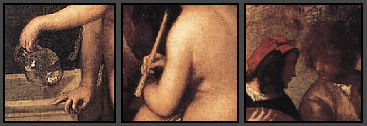
"Varro's description definitely seems to be most fitting here. Keeping the Muse Triplet in mind, it does not require too much imagination to see them in The Pastoral Concert, one born from the movement of water, another who makes sound by the movement of air, and a third, who is embodied only in the human voice."
It is a promise that has been carried on iconographically, from Antoine Watteau (“L’embarquement pour Cythère”, 1717), Edouard Manet (“Le Déjeuner sur l’Herbe”, 1863) to today’s art (Jeff Wall, “The Storyteller”, 1986), although it has never been redeemed. It is obviously a big jump from the allegory of inspiration to Rococo desire, from bourgeois leisure time to sociological studies. Nevertheless, Giorgione’s original image keeps appearing. It has become a pastoral theme that dominates even film and advertising, though in a vulgar and banalized manner for the most part.
At first glance,musician and multi-media artist William Engelen’s seven-part composition “Partitur Stadtgarten” also continues the process of thinking about this pastoral theme. For instance, let us look at the three female performers singing in Arabic, on the meadow of the Stadtgarten in Aachen. At first they seem like living relatives of Giorgione’s image. And yet they are sitting on a cloth that Engelen himself has conceived, in a landscape that does recall Arcadia, but which is urban, as the name states. They sit quietly on open ground, in front of a backdrop of a basin and fountain. Streetlights, pavement and artificial islands of flowers complete the furnishing of a typical urban garden. As far as the ambience goes, Engelen’s pictorial design – for thatis what it is – can be distinguished from Giorgione’s, and yet it is more like him than those who came after – Watteau, Manet, or Wall.
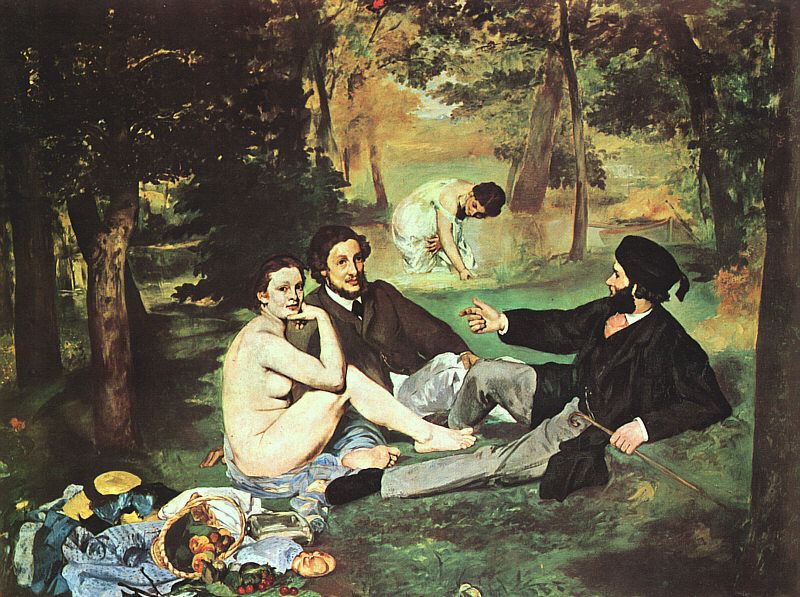
Three Pipe Problem:Adored by many, and heralded as one of the progenitors of the wildly popular French Impressionist style, Manet delivered us his own rendition of a Country Picnic, with the charged sexual undertones of The Tempest with Le Dejeuner Sur L'Herbe(The Luncheon on The Grass), painted between 1862-3. It can be be viewed at the Musee d'Orsay in Paris. The uneasiness this painting caused to many viewers at the time is a bit more difficult to grasp as a modern viewer. However, unraveling some of Manet's past, and exposing some of the new revised iconology of this painting makes it an ideal example of the portents of Modern Art and the impending doom for the poetic and decorative ideals of an artist such as Giorgione. Whilst Manet's Dejeuner seems to have captured the imagination of writers such as Emile Zola(whose fictional work The Masterpiece(pub.1886) is inspired by this painting), and later artists such as Picasso, at an essential level is reminiscent of one of those Kitsch paintings featuring unlikely characters in unlikely settings.
“What is special about The Pastoral Concert? The dreamlike, ethereal haze that pervades the image was something unique to The Renaissance. The battle with Realism which Medieval artists toiled with has been disregarded for a battle to depict the skewed realism of the mind. The two central figures are deliberately shown to not notice the lovely nudes – rather than jumping to conclusions about the homosexuality of this central pair, it is important to remember the tradition of symbolism, handed down from painters of antiquity, which eventually were to be organised into emblem books.” ( DeStefano )
…The musical practice alone opens up an atmospheric space that moves beyond the Aachen Stadtgarten to something strange with which we have all become familiar. By this, is meant the creative act outside, done together – not in the sense of drumming selfassertion, but as an expression of concentrated, relaxed, artistic communication in an open environment. Even stranger, though, is the Arabian singing in Engelen’s composition ”Suleika”. However, it remains in our minds, although it is estranged from us because we want to exclude it. And yet the ornamental lines of this singing seem like the heralds of another Arcadia, which, in the nineteenth century, became an especially desirable landscape. Even before Gérard de Nerval and Gustave Flaubert, Goethe had paid homage to this new Arcadia in his “Western–Eastern Divan” (1819, 1827), without having been there himself, however.
Goethe was inspired by the fifteenth-century Persian poet Hafis and wrote his new songs as a sign of his propinquity. During this period, the aging Goethe, in his ”second puberty”, was mainly traveling through Germany’s countryside and gardens. The Suleika he sang of (“an ornament of virtue”) was personified by Marianne Willemer, a beautiful, convivial, musical woman, who answered his poetry with her own. However, Marianne Willemer was a married woman, and this is the kind of thing that leads elderly people to youthfully pine away, inspired by Oriental songs in the sense of ”what we Germans call the Geist”, meaning, of the “overall view of the nature of the world, irony, liberal use of talents” (Goethe)….
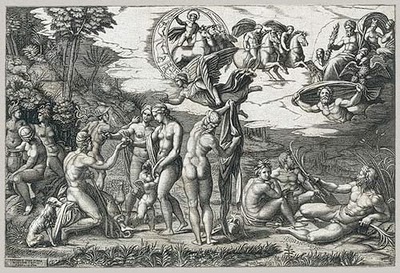
"Manet's compostion for Dejeuner was lifted directly from Marcantanio Raimondi's The Judgement of Paris(1515), which is stated to be originally designed by Raphael."
…Engelen exposes what Giorgione does not mention, namely, the texts and notes behind his image, and in this way leads us, as he does with his architectural models, to a realm of transparence and graceful mobility. He inversely transforms Giorgione, and with this step, also transforms Goethe, who transformed Hafis, who in turn transformed the nineteenth century that transformed Giorgione, who transformed the philosophies of his time, which are transformed into interpretive models of images in the twentieth century, and so on. On closer inspection, the three singers in the Aachen Stadtgarten start an eternal process of transformation, which begins with images and creates images. That is the poetry of the pastoral, the untamed power of inspiration. Engelen, whose legends describe the sounds, lays out his notations as if they were images of landscapes or other things, composed of
the visual. A variety of walks (“Im Friedhof”), the growth of nature (“Bruchstücke”), a diagram of his eyeball (“Augenblicke”), or the map for the city garden (“Wanderwege”) are images that become music through notation, not illustrative in the sense of programmed music, but sculptural, like the duration of notes, according to Marcel Duchamp, who employed the term “musical sculpture”. “Duration – notes that start at different points and form a sonorous sculpture that lasts.” The bodies of the musicians should not disappear, in an act of symphonic engulfment. They remain present, as bodies that make sound in a landscape.
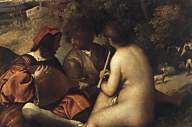
Hoocher:The female figures in the foreground are the Muses of poetry; their nakedness reveals their divine being. The standing figure pouring water from a glass jar represents the superior tragic poetry, while the seated one holding a flute is the Muse of the less prestigious comedy or pastoral poetry. The well-dressed youth who is playing a lute is the poet of exalted lyricism, while the bareheaded one is an ordinary lyricist. The painter based this differentiation on Aristotle's "Poetica".
ADDENDUM:
Unlike diverse notation experiments by composers such as Edgar Varése, Philip Corner, John Cage, and others who worked with cartographic systems, Engelen stays in one place, so to speak. He does not compose the world for a narrow concert hall, does not produce historical images. He remains pastoral. This is not limitation, but knowledge of the ecology of possibilities and intensities, oriented toward that ”becoming”,of which Gilles Deleuze and Félix Guattari speak in Thousand Plateaus. ”In a general sense, we call a refrain any aggregate of matters of expression that draws a territory and develops into territorial motifs and landscapes (there are optical, gestural, motor, etc., refrains). In the narrow sense, we speak of a refrain when an assemblage is sonorous or ‘dominated’ by sound – but why do we assign this apparent privilege to sound?” The refrain of the pastoral knows no privileges. It is there, wherever it takes place. It shows us the territory as image and mobilizes acoustic opticsas the presence of bodies making music in the landscape. The privilege of the pastoral is to be able to expose the sources of inspiration as visual science for music. The landscape
becomes musical and vice-versa. We should listen and look, for we can lose everything, if we remain as we are. ( Michael Glasmeier )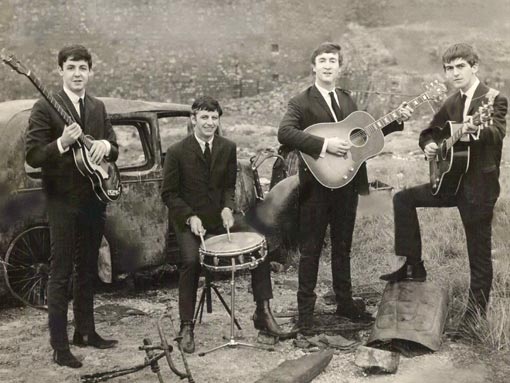
“Looking from the perspective of a modern viewer, it is easier to dismiss The Pastoral Concert as an idealised image, depicting a fantasy conjured from the floral mind of an artist with Poetic leanings. Whilst this is not an inaccurate description, it does not do the image justice. Like film and music, Art should have the ability to traverse the boundaries of reality and imagination, and to appeal to those parts of us that constantly yearn for the wondrous and beautiful. In this sense, The Pastoral Concert is a tremendous achievement.”
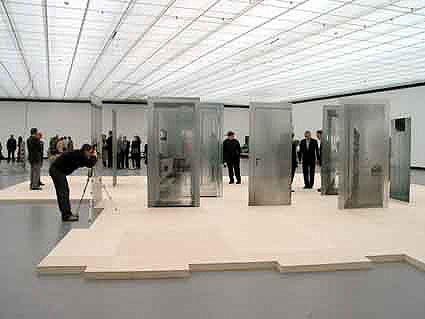
"The works of William Engelen oscillate between fine arts, architecture and music. They are at the same time exhibition pieces, performances, musical scores and architectural models. He re-arranges systems of spatial markings in logical and sequential patterns, and presents these as a visual theatre to the viewer . For the exhibition Made in Berlin , William Engelen will show four sculptures. One of them is a script for a musical theatre piece entitled “Slamming Doors'. The setting is an animated interior, with only the doors remaining. The walls have completely disappeared. These doors, made of different materials, have become musical instruments emitting varied sounds. Three actors seen moving through the space play these ‘instruments' with their bodies, singing or speaking on cue. This sculpture is to be seen as a script for a large scale musical theatre piece. The other sculptures on show present performances staged around different movements and actions set in the same space."
a
